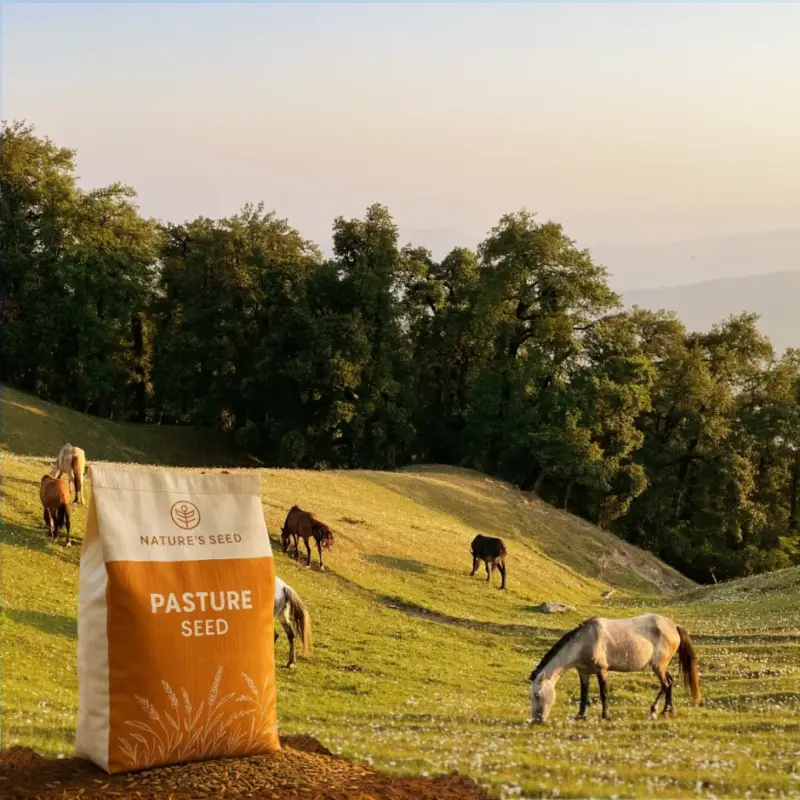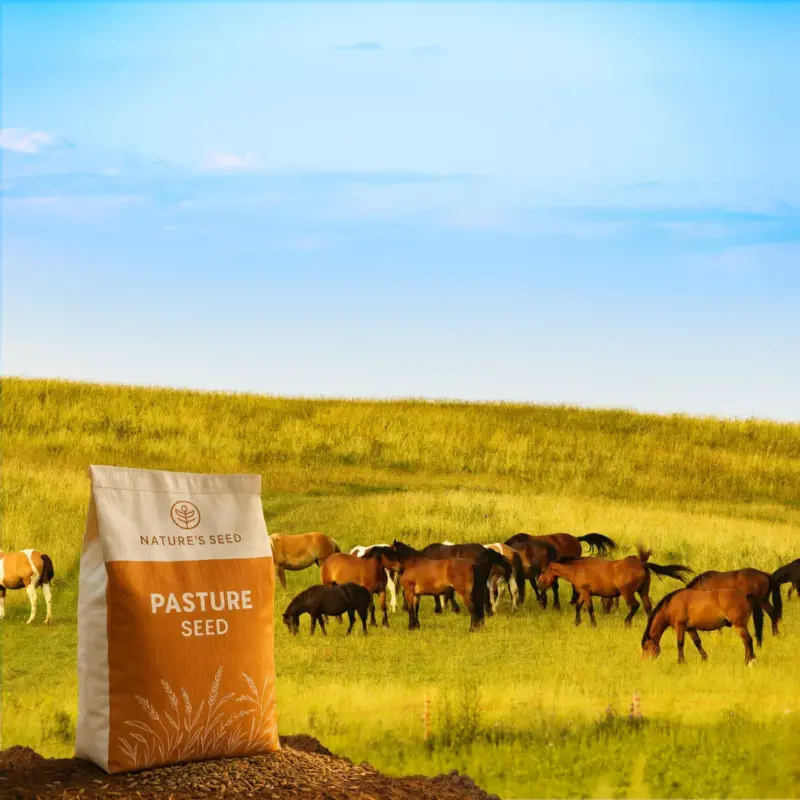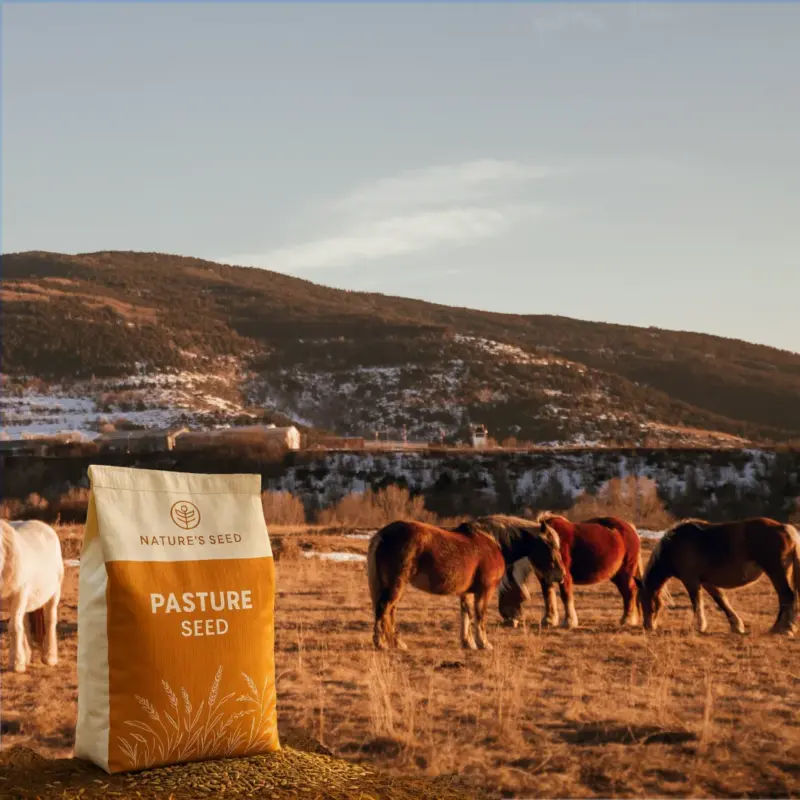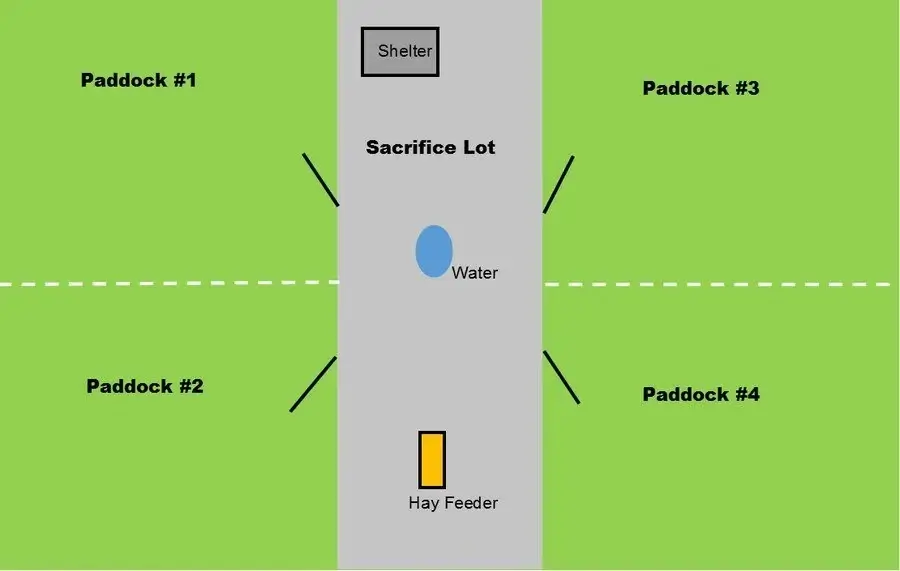Our Horse Pastures Products
The average horse eats about 1 to 1.5% of its body weight every day
A diet like this equates to two to four acres of pasture land per horse. Without the proper acreage and forages, a horse can’t get the necessary nutrients it needs to thrive.
Although you don’t have to feed your horses on pasture only, many horse owners find it beneficial because it’s cost-effective and relatively easy to maintain.
To get the best out of your pasture, you should use the highest grade horse pasture seed available. You should also use the right combination of grasses and legumes for your climate and horses.
Horse Pasture
What Is Horse Pasture Seed?
Horse Forage Mixtures
How To Decide
When deciding what to use to establish your pasture, you can opt to mix your seeds yourself by ordering common pasture seeds like tall fescue, Kentucky bluegrass, and orchardgrass. Or, you can purchase our pre-mixed pasture seeds.
Consider Your Pasture
Regardless of which option you choose, you must carefully consider the grasses and legumes in your pasture. They all have different nutrient contents and varying palatability, while others grow too fast or slow if planted alone.
Quality
Is One Horse Forage Mix Better Than Another?
Our Quality Seed
At Nature's Seed, we only offer premium-quality seeds and species blended at the proper ratios, so you know your horses will benefit from the various grasses and legumes in any horse forage mix you buy.
However, the seed mixture that’s right for your property depends on your regional location, the breed of horses you have, and why you’re raising them, whether for racing, farming, or riding.
Not all grass grows the same. In fact, areas with extreme temperatures, like those found in Texas or New England, are places where certain types of pasture seed will struggle to grow or won’t grow at all.
Ultimately, in each region of the country, there are grasses that grow better than others. The challenge is finding what works in your particular region.
Consider the environmental elements of your region, like the soil condition, the amount of sun and shade, and how high the temperatures can get in the summer. When choosing pasture seed, don’t forget to factor in other essential information like nutritional value, grazing tolerance, disease resistance, and water requirements.
This information is crucial in finding the best seed mixture for your horses so that they can eat well all year. To help you find a suitable seed blend, we created a pasture seed map that highlights specific regions and the best horse pasture seeds for each location.
All you have to do is search for pasture seeds that will work well in your region, and the search results will provide you with some options.
When comparing pasture seed blends, consider whether what’s in the mixture will appeal to your horses, in addition to climate, precipitation, pasture size, number of horses, and whether or not you're using rotational grazing.
For someone living in the Great Lakes or New England regions of the country, you’ll need a horse forage mix that can withstand the severe cold and icy weather in those areas.
We include hearty grasses and legumes like orchardgrass, Kentucky bluegrass, perennial ryegrass, Timothy, and alfalfa because they can sustain the extreme weather conditions and are well-known for their palatability.
You’ll need a different horse pasture seed mixture in the Great Plains region, which experiences snowy winters and hot summers filled with thunderstorms. The difference between this blend and the previous one is that the Great Plains mixture includes meadow brome, crested wheatgrass, and tall fescue (endophyte free).
And you’ll need a vastly different mixture in the southwest semi-arid steppe region, where hot temperatures persist most of the year with minimal rain. The grasses in this mixture must sustain heavy grazing and fluctuating temperatures between night and day.
For this reason, we include Bermudagrass, crested wheatgrass, tall fescue (endophyte free), and white Dutch clover in the pasture seed mixture. These resilient blends help your horses eat all year regardless of the weather.
Our carefully formulated seed mixtures take into consideration the climate, grazing needs, and nutrient needs of your horses. We also ensure all of our forage blends contain grasses and legumes that horses like to eat.
Why?
Why Should You Use Horse Pasture Seed?
Dietary Needs
Like people, horses need a balanced diet of fat, carbohydrates, protein, vitamins, and minerals. The amount and type of vitamins and minerals needed for a healthy lifestyle vary somewhat depending on the horse's age.
Horses greatly benefit from diets rich in phosphorous, calcium, chloride, potassium, sodium, magnesium, and sulfur. Young horses will benefit from additional copper and zinc in their diet. Additionally, all horses need plenty of vitamins, like vitamins A, D, E, K, C, and the B-complex.
With the right combination of horse pasture seed and legumes, you can provide the best pasture grass for horses to meet their dietary needs.
Fertilization
Fertilization is a common struggle for farmers running large pastures. Many farmers and horse owners will adopt rotational grazing to help the fertilization process, but that isn't always enough.
Legumes can solve many of the problems that come with planting pasture seed. The most common legumes in horse pasture seed are alfalfa and white Dutch clover. They're an excellent source of protein, calcium, and energy.
But they do so much more than feed your horses — they fertilize the soil as well.
Legumes restore nitrogen levels in the ground, which helps all other plants grow. Pairing legumes with grasses balances out your pasture. Since grasses have a high-nitrogen usage rate, planting legumes helps restore the soil.
Having a natural fertilizer is a great way to supplement and cut back on artificial fertilizers which can leach into the environment.
Extending the Grazing Season
One final benefit of using horse pasture seed is that your horses can eat healthy diets all season with the right combination of grasses and legumes, as well as proper pasture management.
In some climates, using a mixture of warm and cool-season grasses is a tactic used to beat “summer slump” and winter dormancy issues of cool-season or warm-season only forages. Note that this tactic doesn’t work in every climate, so be sure to contact us to see if it’s an option for your horse pasture.
Common Seeds in Mixtures
Alfalfa
Alfalfa is one of the more common legumes in our horse pasture seed mix. Each blend with alfalfa will produce a pasture that contains no more than 10% alfalfa. There are a few reasons for this:
- It multiplies and spreads quickly. If there is too much alfalfa in a mixture, the other forages could be suppressed.
- Alfalfa is a nutrient-dense forage compared to grass, and a diet of pure alfalfa would be too rich for most horses. In fact, some horses should only be grazed on grass only.
White Dutch Clover
White Dutch clover is another common legume in our mixtures. Its principal use is similar to alfalfa — filling space between grass, replenishing the soil's nitrogen, and providing horses with a tasty treat.
The benefit of using white Dutch clover in your pasture is that it doesn't require any fertilization for it to grow. It's cost-effective and proliferates, which meets the needs of horse-owners and horses alike.
Grass Seeds
When designing our pasture seed, we carefully consider which grasses to include. Every grass has a set of strengths and weaknesses, but they also grow better than others in specific regions.
Review this chart to learn about the strengths and weaknesses of specific seeds in a mixture and to determine if supplemental food is necessary.
|
Grass Seed |
Strengths |
Weaknesses |
|---|---|---|
|
Orchardgrass (cool-season grass) |
|
|
|
Kentucky Bluegrass (cool-season grass) |
|
|
|
Perennial Ryegrass (cool-season grass) |
|
|
|
Timothy (cool-season grass) |
|
|
|
Tall Fescue – endophyte free (cool-season grass) |
|
|
Understanding Your Pasture
Understanding what goes into your pasture is just as important as organizing your pasture. To get the most out of your horse's pasture seed, you need to let it germinate, grow to eight to twelve inches before its first cut or graze, and supplement the grasses with legumes and rest.
Management
Pasture Management
Horses also require plenty of space to graze.
However, this kind of space is not always possible for farmers who might have to share acreage with other livestock or have limited space available.
In situations like this, consider rotational grazing. Rotational grazing is an excellent method of pasture management that allows your horses to get the food and nutrients they need in smaller lots without worrying about overgrazing.
Rotational Grazing
In the situation above, the farmer has four paddocks for his horses to feed with a designated sacrifice lot in the middle with access to hay and water.
Although the four paddocks will have the same seed mixture, the horses won't use all the paddocks at once. Depending on each paddock's particular style and size, you can have your horses graze in each paddock for a few weeks to a couple of months.
During this time, the other paddocks continue to grow. And when they're ready, you can transfer the horses to a new paddock and allow the last paddock to rest.
A rotational method is excellent for horse pasture seed because it gives the grasses and legumes a chance to regrow and strengthen. Horse hooves and appetites cause severe damage to the land, so rest from this kind of feeding helps the land heal.





